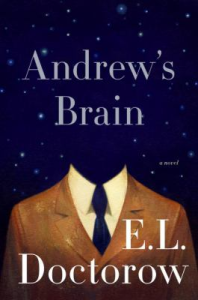by Briana Albright,
LBPH Reader Advisor
Yesterday we lost an American great. E. L. Doctorow (1931-2015) was an author, essayist, and leading figure in contemporary letters. The author of a dozen novels, three collections of short fiction, a stage drama, and numerous essays and commentary on literature and politics, Doctorow was best known for his genre-bending blend of fiction and fact.
Back in 2013, I attended a reading by Doctorow of his then forthcoming novel, Andrew’s Brain. I hadn’t read much Doctorow at the time, but the experience of hearing what was sure to be another great novel read by its author produced in me a strong desire to run home and read everything he’d ever written.
Doctorow was prolific. His novels fictionalize events and figures of 20th-century America, blending history and myth in a way that subtly subverts the dichotomy of fact and fiction. Since hearing Doctorow read from his last novel, Andrew’s Brain, I’ve read three more of his novels and found that I enjoyed each more than the last. Luckily, almost all of his novels have been recorded by the NLS and are available from us here at LBPH or for download from BARD. Discover Doctorow in some of the titles below:
Andrew’s Brain
DB 78414
Andrew, a cognitive scientist, recites the details of his life to Doc, a psychologist. Andrew reflects on his life and failings as a husband and father and questions if he has failed as a human being. Some descriptions of sex. 2014.
Homer & Langley
DB 69642 / CL 13827
Homer Collyer, the blind brother, and his older brother Langley, a WWI mustard-gas victim, become recluses in their Fifth Avenue brownstone, hoarding newspapers and collecting odd things – a model T Ford, typewriters, and surplus Army supplies–until they become imprisoned by their vast accumulations. B estseller. 2009.
estseller. 2009.
Ragtime
DB 44378 / CL 1123
A story set in 1906 New York that incorporates luminaries of the period, including Theodore Roosevelt, Sigmund Freud, and Emma Goldman. A ragtime musician from Harlem falls victim to racist vandalism and seeks redress through violence. Strong language, violence, and some descriptions of sex. 1974.
The March
DB 60676 / CL 12715
This Civil War saga portrays the complex nature of General William Tecumseh Sherman as he leads Union troops through Georgia and the Carolinas. Describes the carnage and destruction that occur as well as the tender feelings that arise as the soldiers proceed. 2005.

